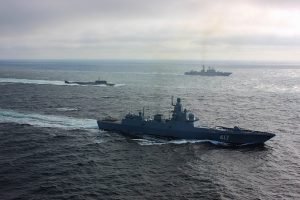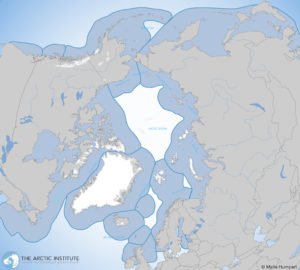The Nuances of Geopolitics in the Arctic

Jegertroppen (all female) from Norwegian Special Operation Commando during winter training in Norway. Photo: Norwegian Armed Forces
Few places have been the source of as much speculation, hype, and broad statements as the Arctic region at the start of the 21st century. Propelled to the agenda by flag-plantings and resource appraisals a decade ago, the Arctic continues to lure researchers and journalists to venture northwards to “the next great game”.
Fortunately, with more attention comes more knowledge as well. Several scholars have now debunked the notion of resource wars in the North, due to the sheer size of the areas in question and the fact that the Arctic states already have ownership over most of these areas, through the Law of the Sea regime. Moreover, the foreign ministries of the Arctic states have highlighted the cooperative traits of the region: “in the Arctic, we work together” to solve problems.
Nevertheless, notions of Arctic conflict and great power politics over the North Pole keep emerging on the political and news agenda. Why is this so, if all is well up in the High North?
Levels of Analysis
A fundamental concept in international relations studies is the “level-of-analysis problem,” first formulated by Singer. In the case of the North, it is particularly useful to distinguish between two levels: the international (system) level, and the regional (Arctic) level. Such an approach helps to tease out the dynamics present in the Arctic, explaining why the idea of conflict persists, and how this is not necessarily counter to ideas of regional cooperation and stability.
Cold War
Separating the international, or system, level from the regional (Arctic) level can help to clarify various misconceptions about the Arctic and the interests of the actors involved. During the Cold War, the Arctic held a prominent place in the political and military standoffs between the two superpowers. It was important not because of interactions in the Arctic itself, but because of its strategic role in the systemic competition between the USA and the USSR.
Recently, after a drop in geopolitical and geostrategic relevance in the 1990s—which enabled various regional cooperative schemes to be established in the Arctic—the strategic importance of the North has risen again.
Arctic re-emergence

Recalling the dynamics of the Cold War, the Arctic’s strategic importance has evolved primarily because Russia is intent on re-establishing its military power, and the Arctic is one domain where it can do so basically unobstructed. This comes not necessarily because of the Arctic itself, but because of Russia’s dominant position in the North, with its the Northern Fleet based in the Kola Peninsula, which houses strategic submarines essential to the county’s status as a nuclear power on the world stage. It is not the melting of the sea ice that has spurred Russia’s military emphasis on the Arctic—it is the importance of the Arctic for Moscow’s more general strategic plans and ambitions.
China in the Arctic
Unlike the case in the Cold War, China has now emerged as an Arctic actor. With Beijing continuing to assert its influence on the world stage, the Arctic will be only one of many regions where China’s presence and interaction are components of an expansion of power in both soft and hard terms. China has been noted as a “near-Arctic state,” a situation which demands involvement from Beijing.
However, China is not accepted as an Arctic state and has largely been excluded from regional politics. Despite the inaccuracies of US Secretary of State Pompeo’s warning in 2019 that Beijing’s Arctic activity risks creating a “new South China Sea,” such statements highlight how the USA sees the Arctic as yet another arena where the emerging systemic competition between the two countries is increasing.
Separating North America and Europe
On the systemic level, the USA can and will engage in regions like the Arctic as it sees fit. However, in North America, the Arctic does not play the same seminal role in national security considerations as it does in Russia or Northern Europe. Although the rhetoric might suggest otherwise, for the USA, the Arctic has served primarily as the location for missile defence capabilities, surveillance infrastructure, and a limited number of strategic forces. It is also of importance to the US Navy and Coast Guard, although the USA has yet to invest significantly in Arctic capabilities and infrastructure.
This bring us to the important difference between overarching strategic considerations, and those that concern the Arctic region specifically. First, security dynamics in the Arctic have remained anchored to the sub-regional level: the Barents area, the Bering Sea/Strait area, even the Baltic Sea region. Thus, it is futile to generalize about security interests and challenges across the whole northern circumpolar region. It makes more sense to discuss security in the different parts of the Arctic, not in the Arctic as a whole. Of these different parts, the European Arctic is undoubtedly the most active and the most challenging.
Cooperation and Conflict
Intra-regional cooperation on other issues has also flourished. Indeed, it has been argued that these low-level forms of interaction help ensure low tension in the North, on the regional level. The emergence of the Arctic Council as the primary forum for regional affairs in the Arctic plays into this setting.
The Arctic states have shown a preference for a stable political environment in which they maintain dominance in the region. This is supported by the importance attributed to the Law of the Sea and issue-specific agreements signed under the auspices of the Arctic Council. These developments benefit the Northern countries more than anyone else, while also ensuring that Arctic issues are generally dealt with by the Arctic states themselves.
Separating the wheat from the chaff
To sum up: On the international level, the Arctic has again risen to the forefront of strategic concerns among great/emerging powers (the USA, Russia, China). This has little to do with events in the Arctic (ice-melting, economic ventures, etc.), and everything to do with the strategic position of the Arctic between these actors. True, we find some intra-regional competition, as well as investments and cooperation. However, here it is difficult to generalize across the Arctic “region,” precisely because of the vastness and inaccessibility of the area itself.
The Arctic states have limited, if any, rationale for engaging in outright conflict (bilateral or regional) over resources or territory—although local rivalries, like that of Norway–Russia persist. However, the Arctic will not become any less important on the strategic level, simply because the USA and Russia are already in the region, and China is increasingly demonstrating its (strategic) Northern interests.
Consequences for Arctic states
This has implications for the Arctic states. Although the Law of the Sea regime ensures primacy to offshore resources, the states themselves must be able to protect their sovereign rights at sea and be present in the Arctic maritime domain. They also need to understand how and why the region is attracting political and economic interest from afar, and must maintain the focus on the area in their national policies, linking security concerns with economic investments and active Northern policies. The rise of the Arctic on the agenda is no passing trend: it is here to stay.
Finally, despite sanctions and conflict in other parts of the world, security concerns (and cooperation) with all relevant actors in the Arctic must not only be debated: such discussions need to be instigated and prioritized by political leaders. The increase in military exercises and—at times—aggressive rhetoric must be examined, discussed and better understood, if we are to avoid missteps that might even lead to an Arctic arms race.
This article was first published by the Georgetown Journal of International Affairs on 5 December 2019.
